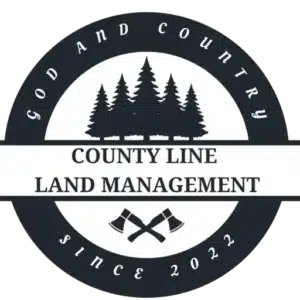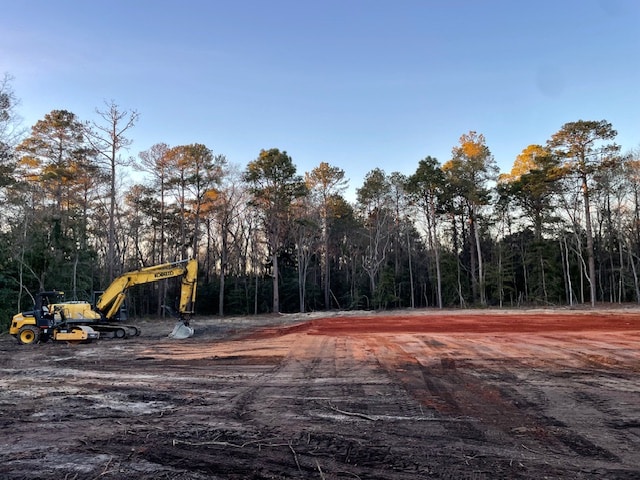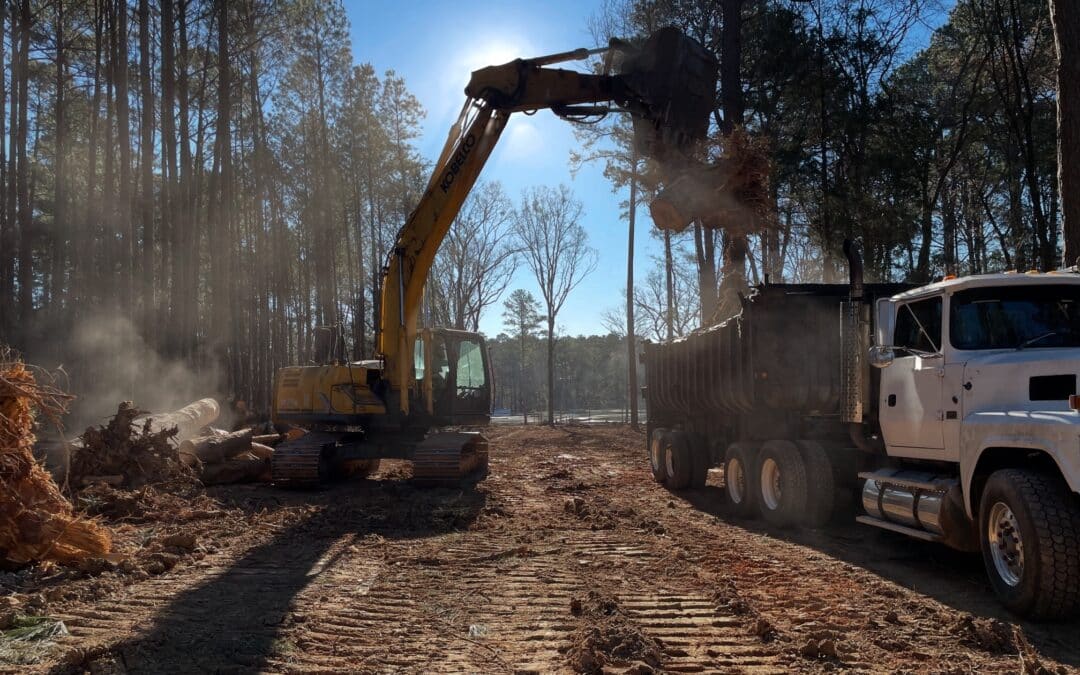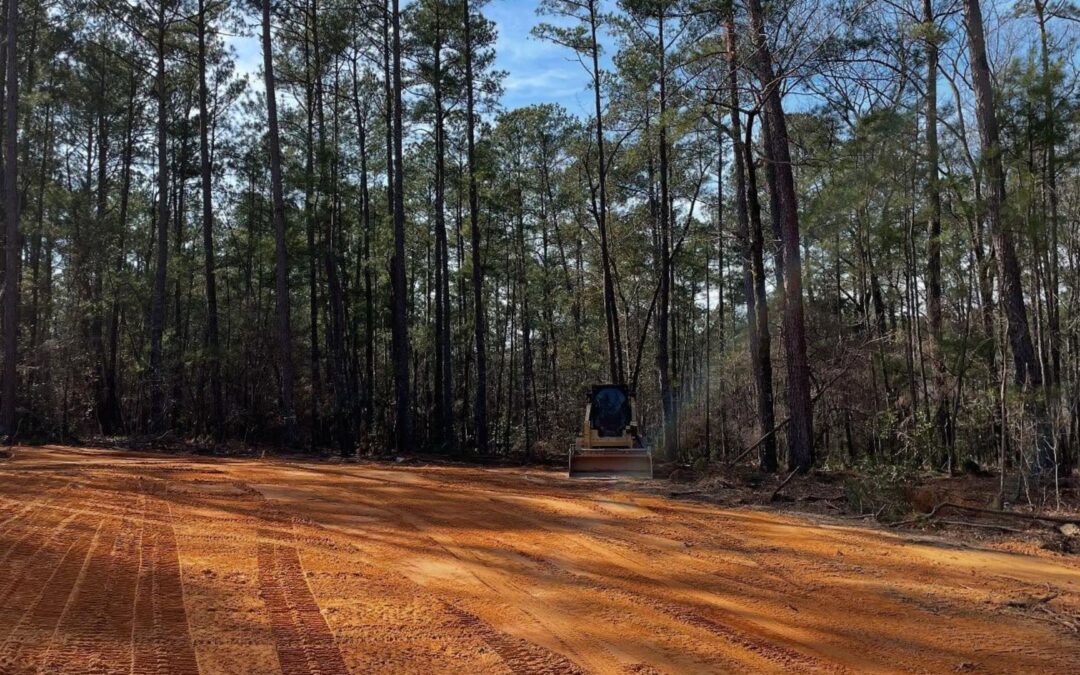Grading isn’t the flashiest part of a construction or land development project, but it’s one of the most important steps you can take to ensure stability, proper drainage, and long-term durability.
Whether you’re preparing for a custom home foundation, laying out a barn pad, or building a commercial structure, proper grading protects your investment and prevents costly repairs later on.
In this post, we’ll explain:
- What grading is and why it matters.
- The most common problems caused by poor grading.
- Key signs that your property might need professional grading.
- How professional grading is done right.
- Tips for maintaining proper grading over time.
Let’s dig in (pun intended).
1. What is Grading and Why Does It Matter?
At its core, grading is the process of shaping the land to ensure proper water drainage, soil stability, and surface smoothness. It’s more than just moving dirt—it’s about creating a foundation for everything that comes next.
Why Proper Grading is Essential:
- Prevents Water Damage: Guides rainwater away from foundations, preventing pooling and erosion.
- Ensures Structural Stability: Creates a solid base for homes, barns, or roads.
- Reduces Erosion Risks: Stabilizes slopes and prevents soil from washing away.
- Improves Usability: Creates level, safe spaces for driveways, pads, and access roads.
👉 Example Scenario:
Imagine building a home on uneven ground without proper grading. Heavy rain causes water to pool around the foundation, leading to cracks, mold issues, and structural damage.
Grading isn’t just important — it’s non-negotiable.
🛠️ Related Resource: Learn about our Grading & Leveling services here.
2. Common Problems Caused by Poor Grading
Improper grading might not seem like a big deal at first, but the consequences can be expensive, dangerous, and long-lasting.
Top Problems Caused by Poor Grading:
- Foundation Damage: Water pooling around foundations can cause cracks, leaks, and structural instability.
- Soil Erosion: Loose or improperly compacted soil washes away during heavy rain.
- Standing Water: Poor grading creates low spots where water collects, becoming breeding grounds for mosquitoes and damaging landscaping.
- Uneven Surfaces: Creates trip hazards and unstable ground for buildings and equipment.
- Increased Maintenance Costs: Repairing drainage issues and foundation damage can cost far more than doing proper grading upfront.
👉 Quick Tip: If you notice water pooling near your foundation, mudslides during heavy rain, or uneven settling on your property, it’s time to call a professional.
🛠️ Related Resource: Get a site evaluation with our team today.
3. Signs Your Property Needs Professional Grading
You might not be a grading expert, but there are clear warning signs that your land needs attention.
Key Signs to Look Out For:
- Persistent Standing Water: Puddles that don’t drain after rainstorms.
- Soil Erosion Patterns: Noticeable channels or soil loss after heavy rainfall.
- Foundation Issues: Cracks in walls or uneven settling.
- Drainage Problems: Water flowing toward, instead of away from, buildings.
- Uneven Surfaces: Noticeable bumps, dips, or uneven slopes in key areas.
If you notice any of these issues, it’s time to consult a professional grading contractor.
👉 Pro Tip: Regularly inspect your property after heavy rain to catch drainage issues early.
4. How Professional Grading Gets Done Right
Professional grading isn’t just about smoothing dirt — it’s about engineering the land for stability and efficiency.
Our Grading Process at County Line Land Management:
- Site Evaluation: Assess the property’s slopes, soil type, and drainage challenges.
- Planning: Design a grading plan tailored to the property’s use (e.g., home foundation, barn pad, access road).
- Cut and Fill: Remove high spots (cut) and fill low areas to create an even surface.
- Drainage Control: Ensure water flows away from structures and critical areas.
- Compaction: Compact the soil for long-term stability and durability.
- Final Inspection: Review every detail to ensure the grading meets our standards.
👉 Quick Fact: Professional equipment, like laser grading tools and heavy-duty compactors, make precision grading possible..
5. Tips for Maintaining Proper Grading Over Time
Grading isn’t a “set it and forget it” solution. Over time, natural erosion, heavy rainfall, and property usage can affect your land’s grading.
5 Tips for Grading Maintenance:
- Inspect After Heavy Rain: Look for pooling water, erosion channels, or soil loss.
- Maintain Proper Landscaping: Use grass or ground cover to stabilize soil.
- Avoid Heavy Traffic on Soft Ground: Heavy machinery or vehicles can damage compacted soil.
- Clean Drainage Areas: Keep ditches, culverts, and drainage paths clear of debris.
- Schedule Professional Inspections: Periodic evaluations ensure long-term stability.
A little attention now can prevent big problems later.
FAQs About Grading Projects
- How long does grading take?
Timelines vary, but most residential grading projects are completed in 1-3 days. - Is grading necessary for all projects?
Yes. Even small structures need stable, properly graded surfaces. - What equipment is used for grading?
We use professional tools like excavators, bulldozers, and compactors for precision results. - Can grading fix existing drainage issues?
Absolutely! Proper grading redirects water flow away from problem areas.
Conclusion: Don’t Skip the Most Important Step
Grading might not be the most exciting part of a land project, but it’s one of the most critical investments you can make. From preventing foundation damage to ensuring proper drainage, grading sets the stage for everything that follows.
At County Line Land Management, we approach grading with precision, care, and long-term stability in mind.
👉 If you’re planning a project, start on solid ground — get in touch with our team today.



